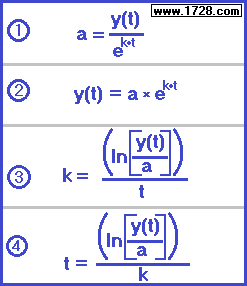|
Tutorial & Calculator Based on natural logs and the exponent "e". To see exponential growth based on common logs and base 10 exponents, click here. To read about exponential decay particularly half-life, click here.

There are four exponential growth problems further down this page.
What was the bacteria population at the beginning of the experiment (four hours ago.)?
a = 80,000 ÷ 2.71828...(.2 • 4) a = 80,000 ÷ 2.71828...(.8) a = 80,000 ÷ 2.22554 Beginning Amount = 35,946 * * * * * * * * * * * * * * * * * * * * * * * * * * * * * * * * * * * * * * * * * * * * * * * * * * * * * * * * * * * *
What will be its population in 2016?
y(t) = 33,476,688 × 2.71828... (.016118877 * 5) y(t) = 33,476,688 × 2.71828... (0.080594385) y(t) = 33,476,688 × 1.0839311486 36,286,425 * * * * * * * * * * * * * * * * * * * * * * * * * * * * * * * * * * * * * * * * * * * * * * * * * * * * * * * * * * * *
What is the interest rate of this account? For the purpose of solving this problem we'll say that: a=100 y(t)=200
k = (ln [200 ÷ 100]) ÷ 8
k = (ln [2]) ÷ 8
k = (0.6931471806) ÷ 8
k = 0.0866433976
k = 8.66433976%
* * * * * * * * * * * * * * * * * * * * * * * * * * * * * * * * * * * * * * * * * * * * * * * * * * * * * * * * * * * *
How long will it take the population to triple? (That is, when will the population be 7,500?)
k = (ln [y(t) ÷ a]) ÷ t
k = (ln [3,000 ÷ 2,500]) ÷ 2
k = (ln [1.2]) ÷ 2
k = ( 0.182321556793955 ) ÷ 2
k = 0.0911607783969773
t = (ln [y(t) ÷ a]) ÷ k
t = (ln [7,500 ÷ 2,500]) ÷ 0.0911607783969773
t = (ln [3]) ÷ 0.0911607783969773
t = (1.09861228866811) ÷ 0.0911607783969773
t = 12.0513702053 hours
Answers are displayed in scientific notation and for easier readability, numbers between .001 and 1,000 will be displayed in standard format (with the same number of significant figures.) The answers should display properly but there are a few browsers that will show no output whatsoever. If so, enter a zero in the box above. This eliminates all formatting but it is better than seeing no output at all.
Copyright © 1999 - 1728 Software Systems |
|||